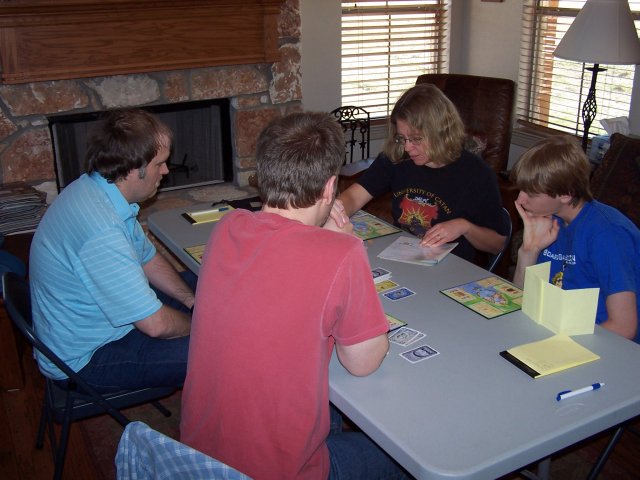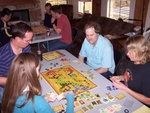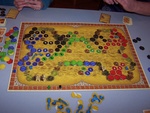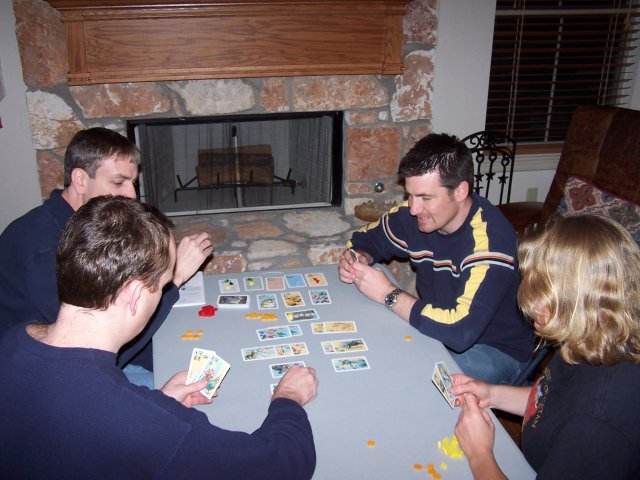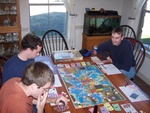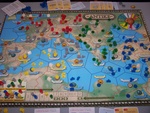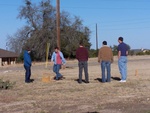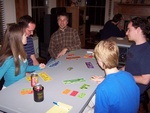
February 15, 2006Game Day Report for February 11, 2006by Susan Rozmiarek Wow! We had 16 gamers playing 16 games today, including three folks who found us via the internet and drove all the way from College Station. Also visiting the Game Ranch for the first time was Clark, a past regular of our old Round Rock group, and his friend Weldon. Hopefully they all enjoyed themselves enough to come again. Wow! We had 16 gamers playing 16 games today, including three folks who found us via the internet and drove all the way from College Station. Also visiting the Game Ranch for the first time was Clark, a past regular of our old Round Rock group, and his friend Weldon. Hopefully they all enjoyed themselves enough to come again.
Even though I wasnít able to get any of my ďgold starĒ games played (after wading through the Mare Nostrum rules beforehand to be ready), I did manage to play three different games that are review copies which was nice. I am now ready to write reviews on two of them. OstiaThis game was newly arrived from Mayfair Games shrouded in a cloak of good buzz from Essen. I was eager to play it although I was disappointed to see that the major mechanisms were auctions and blind simultaneous card selection. Sheesh, how many of these types of games do we need? Fortunately, this seems to be another Frankenstein game of older, familiar game parts coming together to make something new and nice but a little bit different.Players are randomly dealt five resource cards, keep one, and auction the rest in sets of two. After the auctions, players divvy up their cards into three categories Ė cards they are going to sell in the Forum, cards they are going to keep, and cards they are going to offer to the Senate for victory points. After choosing where to allocate their cards, the cards in the Forum and Senate are revealed. Players get money for the resource cards that they placed in the Forum based on a chart. The amount given for each resource depends on how many total of that type were offered up for sale by all players. The fewer of a type offered, the more they are worth. Cards offered in the Senate are valued based on a chart depicted on the Senate cards. The type of resources desired by the Senate varies from round to round and players will always be able to see the current Senate card as well as the one for the next round. The person who made the most valuable offer gets three victory points, second place two, and the third place one. The twist here is that only three out of the five resource types may be offered in the Forum and Senate combined. So, this makes the allocation a little trickier. You canít just put all your most valuable Senate cards there and your trash in the Forum to sell. You buy storehouses to carry cards over to the next round which can be nice since you know what resources the Senate will want ahead of time. At the end of the game (five rounds) there are some additional victory points awarded for most money and for having unique resources stored in storehouses. It took us all a bit to figure out how the game worked. We seemed to have hard time remembering the three resource type limit in the Forum and Senate. There is a heavy penalty for forgetting and Kevin got burned badly by it one round after we ended a grace period for forgetting. Nevertheless, he was able to pip me for the win, much to his delight. The scores were all very close. I thought the game felt a little long but perhaps that was because we were all learning it. Overall, I enjoyed it a lot and it worked smoothly even though most of it didnít feel all that original. I do have some issues with some of components, in particular the flimsy money and cards.
HaciendaThis game keeps getting played but never with me so I was kind of pushy getting it to the table. Iíd wanted it based on designer and description alone because it sounded like something Iíd like. I was right. It has a lot of the tension that I love so much in Ticket to Ride with trying to collect the right cards and use them to grab spots on the board before somebody beats you to it. Hacienda provides you with more choices and paths to victory however, making it a bit (but not much) more complicated. You also have some money management but money didnít seem particularly tight to me.Mark was obviously trying to connect as many markets as possible while also creating a long animal chain. Weldon played much of the game uncontested at one end of the board until we realized his threat. Roxana got cruelly cut off by both Mark and me although I had to do it in order to be able to reach a market. I ended up being able to place two water tiles that netted me about 20 points. That and a seven-tile land chain with a hacienda was enough to catapult me to the top for the win. Nice game and a Spiel des Jahres contender this year, Iíll bet. Iím looking forward to trying some other maps. I do dislike some of the art. The animal faces are too angular or something and I thought the landscape tiles could have been a little prettier. Obviously, Iíve gotten spoiled and picky about this sort of thing!
Hey! Thatís My Fish!I got to play this twice tonight and it continues to rise in my esteem. I was horrified in my second game to find out that Iíd been teaching it incorrectly. I thought that players could place their penguins on any tile at the beginning of the game but the rules clearly state that they must be placed on a tile with one fish. I donít know how I missed that but it doesnít seem to affect the game much. Everyone that I teach this to seems to like it.ArkI was planning on getting this one just on the basis of adorable animal art alone. Has Doris Matthšus ever outdone herself this time! If you thought her famous hedgehogs were cute, wait until you see her mercat and rabbit! And yes, the hedgehog is in the deck as well. Fortunately, there seems to be a decent game to go with the irresistible art. The rules on animal placements seem a little daunting as they are explained, but once the game gets going and you think about them from a logical standpoint, they really do make sense. I love the balance mechanism of keeping the ark from tipping. Between having to consider that, the climate of each cabin, and the restriction of which animals can share space, itís a nice puzzle figuring out how to place your cards. Meanwhile, the struggle for majorities in the different animal types drives your card selection. The ďsecret petĒ is a fun addition that adds a little uncertainty and surprises to endgame scoring. The theme really works great with this game and I can hardly wait to get a copy. Iím betting my kids will like it a lot.
PalatinusWhen I first played this game I was hopelessly confused but I thought that it was probably really clever once you figured it out. After about four plays Iím about done with it. Yes, you can make some good guesses about your opponentsí blind placements, but youíll find yourself locked in a brain freeze trying to figure out the ramifications to the endgame scoring. Perhaps it is just too clever. My puny human brain is not up to the task. Luckily, the game is so short (if it hasnít fallen victim to analysis paralysis, a distinct possibility) that the pain is soon over. As a matter-of-fact, the closest thing to a positive comment thatís been uttered by others in my games so far is ďat least itís short.Ē Yet, I still keep thinking there is a good game in there that I just canít grasp. But, with so many games vying for my time, I think Iíve about given up trying.Hornochsen!This game is the more strategic cousin of 6 Nimmt! Now you are not only trying to avoid the red horns; you are also trying to collect green horns so itís not just a simple matter of trying to avoid taking any row. Not only that, you can play from 1 to 3 cards on your turn instead of simply one. Plus, player turns are taken sequentially instead of in a simultaneously choose and reveal guessing manner so there are many more decisions required. I donít particularly favor one game over another; it just depends on my mood at the time. This turned out to be a nice closer for the evening even though I came in dead last. I had poisoned an already nasty row thinking that there was no chance that Iíd have to take it. Guess what happened.
For more pictures from this gaming session and others, see our Gaming Picture Gallery.
Posted by susanroz at 1:03 PM
| Comments (1)
February 12, 2006Parlay - First Impressionsby Susan Rozmiarek I accepted a review copy of Parlay with a bit of hesitation. It describes itself as ďall the fun of poker and word games rolled into oneĒ which immediately set off the warning bells. Here is yet another game trying ride the wave of the current poker craze. The stores are full of them. And I donít even really like poker. Despite my low expectations, I read the rules and brought it out as an opener with my game group. Guess what? It was actually pretty enjoyable and had a nice twist. In fact, if you like word games, youíll probably find Parlay to be rather enjoyable. I accepted a review copy of Parlay with a bit of hesitation. It describes itself as ďall the fun of poker and word games rolled into oneĒ which immediately set off the warning bells. Here is yet another game trying ride the wave of the current poker craze. The stores are full of them. And I donít even really like poker. Despite my low expectations, I read the rules and brought it out as an opener with my game group. Guess what? It was actually pretty enjoyable and had a nice twist. In fact, if you like word games, youíll probably find Parlay to be rather enjoyable.
The rulebook describes several ways to play the game, presumably based on a few of the common variations of poker, including the ever popular Texas Hold ĎEm. We tried the first version listed, Quick Draw. The Parlay deck is a regular deck of high quality playing cards with the addition of a letter and its numerical value on each card. As in Scrabble, rarer letters have higher values. The object of the game is to score the most points based on the best word hand AND the best poker hand. The game is played to 500 points. In Quick Draw, players are dealt a hand of five cards with two community cards dealt face up on the table to form a hand of seven total cards. Players can then choose to discard and be re-dealt up to three cards. After having a chance to evaluate their hands, players now must secretly decide whether to ďstayĒ or ďfold.Ē Nice plastic chips are provided to indicate their decision. Before revealing their decision, each player announces their word and others can challenge it. Correctly calling a bluff earns bonus points. Now players reveal whether they are staying or folding. If a player folds, he adds up the letter points for his best word formed with the cards from his hand. This is his score for that hand. Players who decide to stay are eligible for some nice bonuses, including one for best poker hand, and one for a long word. Players add up their word score and any bonuses to get their total hand score. Hereís the twist Ė of the players who stayed, only the player with the highest total hand score gets his points; the others who stayed get zero points for the hand. This then, presents a dilemma for players each round. Do you fold for guaranteed points, or do you stay in for the chance for the bonuses but risk not getting anything at all? Parlay felt more like a word game than a poker one to me. The Scrabble player in our group coasted to an easy victory. I do need to mention that there are a few people in my gaming group that do not enjoy word games and Parlay was no exception. Also, the bluffing and money gambling element of poker has been removed so it might not appeal as much to fans of real poker. However, this does make Parlay a good choice for families and the poker aspect does provide tension in the game. As with many card games, luck of the draw greatly influences your chances of victory, but there is a nice mix of skill and risk taking as well. Based on my one playing, I can easily recommend Parlay to fans of word games as a light filler. I look forward to trying some of the other variations.
Posted by susanroz at 5:42 PM
| Comments (0)
February 7, 2006Blogs vs. BGGby Susan RozmiarekThere always seems to be an ongoing controversy over at BoardgameGeeek (BGG) about personal blogs. Apparently many people are concerned that the explosion of blogs over the past year is fragmenting the gaming community. These folks seem to feel that these websites draw content away that they would rather see centralized at BGG. As someone who enjoys blogging a great deal, Iíd like to explore my own thoughts on the issue. While it is very gratifying to my ego that there are a few others who read and enjoy what I write here, this blog is first and foremost a scrapbook and journal for ME. I never really understood many of my friendsí fascination with scrapbooking. I have neither the patience nor the craft skills to sit down and arrange photos and cutouts on a page of paper. Then I realized that that is exactly what Iím doing with this blog. It is a record of memories presented with my (and Edís) personal touches that I hope to be able to go back and enjoy 10 or 20 years from now. While I would like to think that BGG will still be around far into the future and I can go back and look at what Iíve written, there is no guarantee that it will still be there. To me, BGG feels like a big public gathering place for gamers and it does its job VERY well. Itís kind of like going to the mall. If you are looking for something in particular, the owners have done a great job organizing the content and you can usually find what you are looking for. In the center though, there is also the big sprawling food court, where gamers of all types hang out and discuss all kinds of things. Here you can often be entertained or find some good nuggets of info, but just as often youíll find that youíve wasted your time with meaningless arguments. There are some nice ways to show your personal side here such as with avatars and badges, but I equate that with the clothes I wear and the bumper stickers on my car. On the other hand, The Game Ranch feels more like my home. I can kick off my shoes and do what I want because Iím in my own private space. I donít have to worry about impressing anybody; I can post my thoughts, comments and news items even if they are very trivial. If people arenít interested they can drive right by without stopping. Even though it may be just an illusion, I simply donít feel the pressure of public scrutiny as much here. This place reflects our personality and itís decorated to our tastes. We can play around with it and experiment. Having your own website and blog is a fun, creative outlet that is a hobby in and of itself. Friends drop by and so does the occasional stranger. (Even unwelcome ones. Thank goodness for spam software). As a matter of fact, new friends have found us through our website. Itís hard to get noticed in the crowds at the mall. I also enjoy visiting others in their virtual homes and hearing what they have to say in their own style. It can be hard to find and get to know them in the crowded public places as well. Itís easy enough for me to post things both here and on BGG that I hope have real value to other gamers, such as reviews. I would hope that other bloggers do likewise. But even if they donít, thatís okay. There are plenty of quality reviews and other information to be found on BGG, with or without the contributions of a few bloggers. Comparing BGG to blogs is like comparing apples and oranges. Like public gathering places and private homes, both have their rightful place in a community. I just really donít see a problem; both can exist and contribute to the hobby in a positive way.
Posted by susanroz at 12:54 PM
| Comments (8)
This page viewed E-mail Ed Rozmiarek with questions or problems concerning this page. Copyright © 2006, Ed & Susan Rozmiarek. No portion of this website may be reproduced or copied without the consent of Ed or Susan Rozmiarek. |
